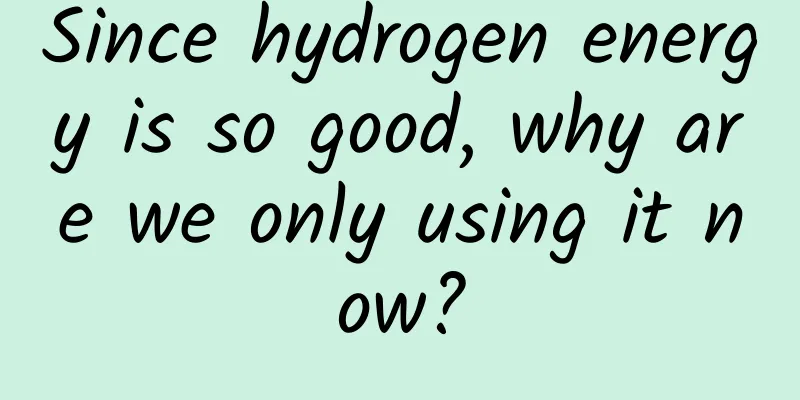Since hydrogen energy is so good, why are we only using it now?

|
At the opening ceremony of the Winter Olympics two months ago, the torch in the form of a "tiny flame" became a classic moment in the minds of many people, and the "behind-the-scenes pusher" of this moment was hydrogen fuel. Similarly, the relay torch at the Winter Olympics also used hydrogen fuel, achieving zero carbon emissions from torch burning in the history of the Winter Olympics. According to data released by the Beijing Winter Olympics Organizing Committee, more than 1,000 hydrogen fuel vehicles and more than 30 hydrogen refueling stations were demonstrated to implement the concept of "green Olympics". How does hydrogen fuel achieve the goal of not emitting carbon dioxide during combustion? Why is it only used now when it is such a good energy source? There are many questions about hydrogen energy. Let's find out together. Part 1 The concept of hydrogen: a promising secondary energy source in the future Hydrogen, with the chemical symbol H, is the first in the periodic table. It is the lightest element and the most abundant element in the universe, accounting for about 75% of the mass of the universe. On Earth, single substances formed under natural conditions are relatively rare. Therefore, hydrogen energy, as a secondary energy source, is different from traditional fossil energy sources such as coal, oil, and natural gas, and is difficult to obtain directly from nature. In this case, why has hydrogen energy become a fuel? This is because the calorific value of hydrogen is very high (120.0MJ/kg), which is 2-4 times the calorific value of the same mass of fossil fuels such as coke and gasoline. That is to say, when the same mass of fuel is burned, the heat generated by hydrogen is 2-4 times that of fossil fuels such as coke and gasoline. At the same time, hydrogen energy has the characteristics of high energy density and various storage forms, and can be deployed with solar energy, wind energy, etc. as energy carriers. The most important point is that hydrogen only contains hydrogen, so the only product of combustion is water, while traditional fossil fuels contain carbon, so they produce a lot of carbon dioxide when burned. Therefore, hydrogen as a fuel can completely achieve zero carbon emissions, which is of great significance in "green environmental protection" and is regarded as the most promising green secondary energy in the 21st century. According to the International Hydrogen Energy Commission, by 2050, hydrogen energy will meet 18% of the world's final energy demand and create a market value of more than 2.5 trillion US dollars. All of the above are enough to show the importance of hydrogen energy. (Photo source: Veer Gallery) Although hydrogen has so many advantages as a fuel, its development and utilization are full of challenges. The development and utilization of hydrogen can be divided into three links: production, storage and transportation, and terminal use. Each link needs to make progress at the same time and overcome their respective technical barriers to achieve the final utilization of hydrogen. Part 2 Production of Hydrogen: Does “Gray-Blue-Green” refer to color? Although hydrogen is a green energy, the production process of hydrogen is not completely carbon-free. Hydrogen can be divided into three types according to its production method: gray hydrogen, blue hydrogen, and green hydrogen. Gray hydrogen is hydrogen produced by burning fossil fuels (oil, natural gas, coal), and carbon dioxide will be emitted during the production process. The production cost of gray hydrogen is low, and the hydrogen production technology is relatively simple. At present, the vast majority of hydrogen on the market is gray hydrogen, accounting for about 95% of the world's hydrogen production today. Blue hydrogen is hydrogen produced from natural gas. While producing greenhouse gases, it will use technologies such as carbon capture, utilization and storage (CCUS) to capture greenhouse gases, thereby achieving low-carbon emission production. Green hydrogen is hydrogen produced through renewable energy (solar energy, wind energy, nuclear energy, etc.), such as electrolyzing water to produce hydrogen through renewable energy. In this process, there is no carbon emission at all, which is also the ultimate goal of hydrogen production. However, due to current technical limitations, the cost of producing green hydrogen is relatively high, and it will take time for large-scale application. (Photo source: Veer Gallery) Part 3 Storage and transportation of hydrogen: a technical job Hydrogen is flammable and explosive. When the volume concentration in the air is between 4.0% and 75.6%, it will explode when it encounters a fire source. At the same time, hydrogen itself is highly active and is prone to "hydrogen embrittlement" with steel, resulting in a decrease in the mechanical properties and plasticity of the storage and transportation equipment materials, and cracking or damage. The transportation of hydrogen energy is usually adjusted according to the different hydrogen storage states and transportation volumes. There are three main ways of transporting hydrogen: gaseous hydrogen, liquid hydrogen, and solid hydrogen. Therefore, under the premise of ensuring safety, increasing hydrogen storage capacity, reducing costs, and improving accessibility are the key points of storage and transportation technology. Hydrogen storage technology can be divided into two categories: physical hydrogen storage and chemical hydrogen storage. (Photo source: Veer Gallery) (1) Physical hydrogen storage Physical hydrogen storage mainly includes high-pressure gaseous hydrogen storage, low-temperature liquid hydrogen storage, physical adsorption hydrogen storage and underground hydrogen storage. High-pressure gaseous hydrogen storage is to compress hydrogen and store it in a high-pressure bottle. This method can be operated at room temperature, has a fast hydrogen charging and discharging speed, and the technology is relatively mature. Cryogenic liquid hydrogen storage is to liquefy hydrogen under low temperature and high pressure conditions and then store it in a container, which has the advantage of a small storage container. However, this method requires the container to maintain a low temperature and thermal insulation vacuum, which is also a big challenge for technology. Adsorption hydrogen storage is the process of storing hydrogen in materials with large specific surface areas by physical adsorption through intermolecular forces. Compared with traditional hydrogen storage in gas cylinders, underground hydrogen storage is to dig a "container" in the underground salt layer to store hydrogen. Combined with the integrated wind, solar and storage project, it can make full use of underground space and effectively store hydrogen. (Photo source: Veer Gallery) (2) Chemical hydrogen storage Chemical hydrogen storage achieves hydrogen storage by combining a storage medium with hydrogen to form a stable compound. When hydrogen is used, the compound is decomposed to release hydrogen through heating or other methods, and the storage medium is recovered at the same time. Part 4 End use of hydrogen: using it in batteries is very effective After we have a good understanding of the production and storage of hydrogen, scientists have also put the use of hydrogen energy on the agenda. Currently, hydrogen fuel cells are a common terminal application of hydrogen energy. As early as the 1960s, hydrogen fuel cells were used in aerospace. After entering the 1970s, with the advancement of technology and the continuous reduction of costs, hydrogen fuel cells have gradually been used in various fields, including power generation, automobiles, ships and drones. (Photo source: Veer Gallery) (Photo source: Veer Gallery) The scene where hydrogen energy becomes the "protagonist" energy at the Winter Olympics is not only a publicity and promotion for the whole society, but also shows the world my country's determination and ability to transform its energy structure and fulfill its commitment to carbon peak and carbon neutrality. The road to hydrogen energy development is long and arduous, but it will come if we keep moving forward. Let us look forward to the day of "hydrogen freedom" together. References: [1] China Hydrogen Energy Alliance. China Hydrogen Energy and Fuel Cell Industry Handbook[R], 2021 [2] Chen, P., et al., Interaction of hydrogen with metal nitrides and imides. Nature, 2002, 420(6913), 302-304. [3] Fu Pan. Research on the current status and difficulties of underground hydrogen storage technology[J]. China Mineral Salt, 2020, 51(6):5. [4] Shao Zhigang, Yi Baolian. Current status and prospects of hydrogen energy and fuel cells. Bulletin of the Chinese Academy of Sciences, 2019, 34(04), 469. [5] Cheng Yibu, Analysis on the development technology and trend of hydrogen fuel cells. Petroleum and Petrochemical Green and Low Carbon, 2018, 3(02), 5. [6] Hydrogen Storage Technology: Materials and Applications, CRC Press, 2012 Produced by: Science Popularization China Author: Nuan Nuan (Dalian Institute of Chemical Physics, Chinese Academy of Sciences) Producer: Computer Network Information Center, Chinese Academy of Sciences The article only represents the author's views and does not represent the position of China Science Expo This article was first published in China Science Expo (kepubolan) Please indicate the source of the public account when reprinting Please indicate the source of the reprint. Reprinting without authorization is prohibited. For reprint authorization, cooperation, and submission matters, please contact [email protected] |
<<: Can the termites flying all over the sky be fried and eaten?
>>: Are probiotics, which can be bought everywhere, really good for health?
Recommend
Li Xiaoyue's Xiaohongshu full-level short video training camp, 30-day community training camp
Li Xiaoyue's Xiaohongshu full-level short vid...
Sleep mini program function, how much does it cost to develop a sleep monitoring mini program?
Nowadays, due to increasing stress on people, the ...
Smart TV ecosystem has diversified gameplay: LeTV gradually becomes the industry benchmark
The battle for the "smart TV ecosystem"...
Don’t just think about eating, be alert to intestinal infectious diseases in summer!
Recently, the temperature in Beijing has reached ...
The rules of selling goods through short video live streaming!
In my experience of creating short videos to prom...
Don’t let your physical examination go to waste! Please learn to understand the symbols on the report →
Are you confused every time you get a physical ex...
In the fierce battle of AI, which BAT can overtake others?
After nearly 20 years of development, the three l...
Jiwei.com: Tesla's orders surged 100% in some parts of the United States
According to media reports, orders for Tesla mode...
Do you need to sleep for eight hours? Is it healthiest to go to bed at 10 or 11 o'clock? Finally, there is an answer
Sleep is a repair process for the human body that...
The more sour the fruit, the higher the vitamin C content? If you want to supplement vitamin C, read this quickly
"The more sour the fruit tastes, the higher ...
Does Kia NP need to rely on price to return to a younger look as the Sportage?
In 2017, Korean cars have not had a good time. Be...
What is the significance of "culturing human pluripotent stem cells from induced somatic cells" to humans?
Recently, the latest achievement of Chinese scien...
Oops! Why are all the cherries I bought deformed? Is it caused by pesticides?
Too long to read Don't worry, the appearance ...
Uncovering the secrets of North Korea's independently developed technology products: They are all "weird"
Recently, the Korea Institute of Science and Tech...









